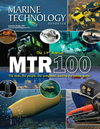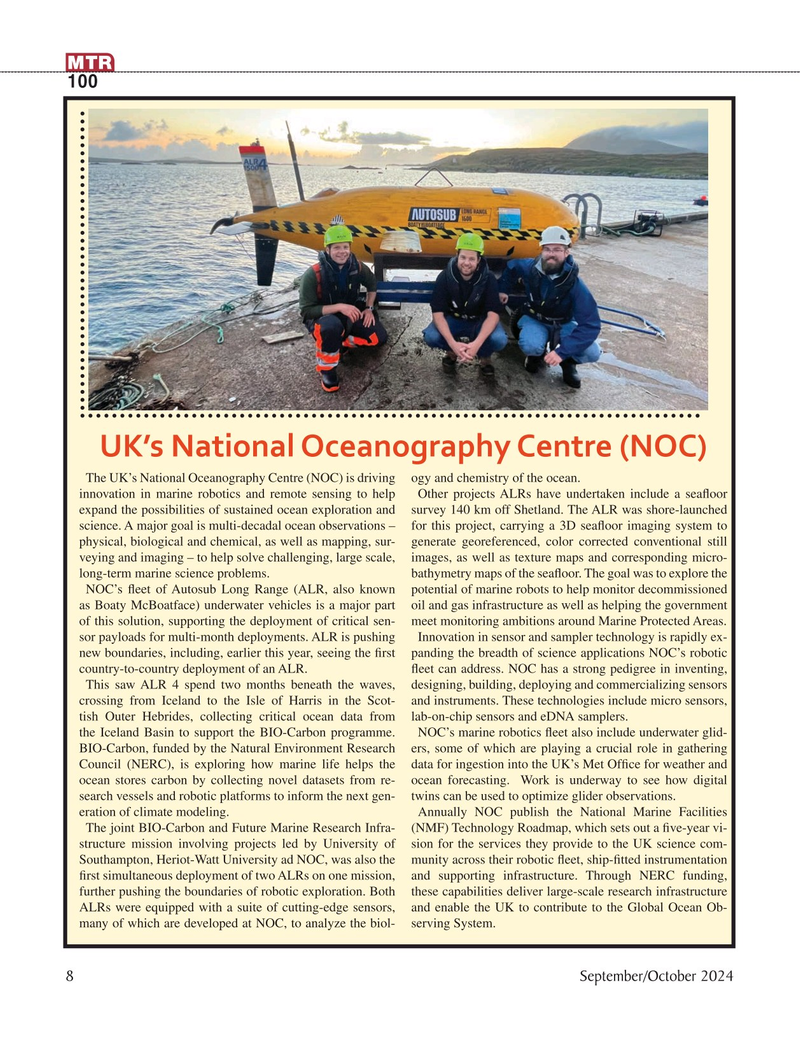
Page 8: of Marine Technology Magazine (September 2024)
Read this page in Pdf, Flash or Html5 edition of September 2024 Marine Technology Magazine
MTR 100
UK’s National Oceanography Centre (NOC)
The UK’s National Oceanography Centre (NOC) is driving ogy and chemistry of the ocean. innovation in marine robotics and remote sensing to help Other projects ALRs have undertaken include a sea? oor expand the possibilities of sustained ocean exploration and survey 140 km off Shetland. The ALR was shore-launched science. A major goal is multi-decadal ocean observations – for this project, carrying a 3D sea? oor imaging system to physical, biological and chemical, as well as mapping, sur- generate georeferenced, color corrected conventional still veying and imaging – to help solve challenging, large scale, images, as well as texture maps and corresponding micro- long-term marine science problems. bathymetry maps of the sea? oor. The goal was to explore the
NOC’s ? eet of Autosub Long Range (ALR, also known potential of marine robots to help monitor decommissioned as Boaty McBoatface) underwater vehicles is a major part oil and gas infrastructure as well as helping the government of this solution, supporting the deployment of critical sen- meet monitoring ambitions around Marine Protected Areas.
sor payloads for multi-month deployments. ALR is pushing Innovation in sensor and sampler technology is rapidly ex- new boundaries, including, earlier this year, seeing the ? rst panding the breadth of science applications NOC’s robotic country-to-country deployment of an ALR. ? eet can address. NOC has a strong pedigree in inventing,
This saw ALR 4 spend two months beneath the waves, designing, building, deploying and commercializing sensors crossing from Iceland to the Isle of Harris in the Scot- and instruments. These technologies include micro sensors, tish Outer Hebrides, collecting critical ocean data from lab-on-chip sensors and eDNA samplers.
the Iceland Basin to support the BIO-Carbon programme. NOC’s marine robotics ? eet also include underwater glid-
BIO-Carbon, funded by the Natural Environment Research ers, some of which are playing a crucial role in gathering
Council (NERC), is exploring how marine life helps the data for ingestion into the UK’s Met Of? ce for weather and ocean stores carbon by collecting novel datasets from re- ocean forecasting. Work is underway to see how digital search vessels and robotic platforms to inform the next gen- twins can be used to optimize glider observations. eration of climate modeling. Annually NOC publish the National Marine Facilities
The joint BIO-Carbon and Future Marine Research Infra- (NMF) Technology Roadmap, which sets out a ? ve-year vi- structure mission involving projects led by University of sion for the services they provide to the UK science com-
Southampton, Heriot-Watt University ad NOC, was also the munity across their robotic ? eet, ship-? tted instrumentation ? rst simultaneous deployment of two ALRs on one mission, and supporting infrastructure. Through NERC funding, further pushing the boundaries of robotic exploration. Both these capabilities deliver large-scale research infrastructure
ALRs were equipped with a suite of cutting-edge sensors, and enable the UK to contribute to the Global Ocean Ob- many of which are developed at NOC, to analyze the biol- serving System. 8 September/October 2024
MTR #7 (1-17).indd 8 10/3/2024 12:28:20 PM

 7
7

 9
9
